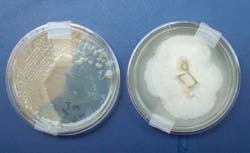
Exercise is an important part of staying healthy and reducing the societal cost of health care. We tend to stop exercising when our bodies signal that we are tired or fatigued. Previously, it was thought that fatigue happened when our energy store became depleted or when the waste products from producing energy accumulated in our muscles causing cramp.
However, research on patients suffering from chronic fatigue syndrome or “Yuppie Flu” has shown that fatigue occurs even though their abilit

There is a better way to determine risk of heart disease than measuring cholesterol, according to a new study by cardiologists from the Research Institute of the McGill University Health Centre (MUHC). This study shows that measuring the amount of a protein called apoprotein B or apoB, is a more accurate and efficient test than measuring cholesterol. These findings will be published in the March issue of the international journal, The Lancet. ôThe tradition in clinical practice is to look at

The method that has been used for the last twenty years to measure the production of laughing gas (nitrous oxide) from different natural sources is not working. Due to this, the size of some of the sources of this greenhouse gas has locally probably been underestimated. This conclusion is drawn by Nicole Wrage in her PhD thesis that she is going to defend at Wageningen University (Netherlands) on February 28.
The research of the PhD student at Wageningen University focussed on the productio

Between 24 and 26 February, a number of trial flights into Dakar using the EGNOS (European Global Navigation Overlay Service) Test Bed system were carried out to show how the planned provision of Global Navigation Satellite System (GNSS) services over Central Africa could be implemented.
ASECNA (Agence pour la sécurité de la navigation aérienne en ASECNA (Agence pour la SECurité de la Navigation Aérienne en Afrique et à Madagascar) has worked with the European Space Agency, the European Com

In what is a first for biology, a team of investigators at The Scripps Research Institute (TSRI) is reporting that the human body makes ozone.
Led by TSRI President Richard Lerner, Ph.D. and Associate Professor in the Department of Chemistry Paul Wentworth, Jr, Ph.D., who made the original discovery, the team has been slowly gathering evidence over the last few years that the human body produces the reactive gas—most famous as the ultraviolet ray-absorbing component of the ozone layer—as p

Research is key step in detoxifying endosulfan toward improving soil and water quality
Scientists at the University of California, Riverside report in the Journal of Environmental Quality (JEQ) that they have isolated microorganisms capable of degrading endosulfan, a chlorinated insecticide widely used all over the world and which is currently registered to control insects and mites on 60 U.S. crops. JEQ, established in 1972, is published jointly by the American Society of Agronomy,

– new calculation confirms standard model of particle physics. Contribution of hadronic vacuum polarization determined with unprecedented accuracy. The magnetic moment of the muon is an important precision parameter for…
Technique may prevent formation of unwanted waves that siphon off needed energy. Heating plasma to the ultra-high temperatures needed for fusion reactions requires more than turning the dial on a…

An international team of astronomers, led by researchers from the Astronomical Observatory of the University of Warsaw, have identified a new class of cosmic X-ray sources. The findings have been…

Antibody that Neutralizes Inhibitory Factors Involved in Nerve Regeneration Leads to Enhanced Motor Function after Acute Spinal Cord Injury. Researchers at 13 clinics in Germany, Switzerland, the Czech Republic and…

How the body’s natural killer cells could fight leukemia. Every year, some 13,000 people in Germany are diagnosed with leukemia. Despite intensive chemotherapy, around one in two of them die….

… eco-friendly reactor converts air and water into ammonia. Producing enough ammonia to feed the world comes with a large carbon footprint;. process described in new UB-led study could help…

How simulations help manufacturing of modern displays. Modern materials must be recyclable and sustainable. Consumer electronics is no exception, with organic light-emitting diodes (OLEDs) taking over modern televisions and portable…

“Neurons that fire together, wire together” describes the neural plasticity seen in human brains, but neurons grown in a dish don’t seem to follow these rules. Neurons that are cultured…

The quest for sustainable energy solutions has been a major focus of scientific research for decades. Solar energy, a clean and renewable source, has emerged as a promising alternative to…

With a processing speed a billion times faster than nature, chip-based laser neuron could help advance AI tasks such as pattern recognition and sequence prediction. Researchers have developed a laser-based…

New technology could remotely identify various types of plastics, offering a valuable tool for future monitoring and analysis of oceanic plastic pollution. Researchers have developed a new hyperspectral Raman imaging…

Artificial Intelligence (AI) has established a strong presence across industries, large and small. The “VoBaKI” research project has empowered small and medium-sized enterprises (SMEs) with an innovative tool to independently…